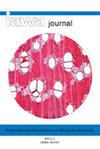Barrier zone formation and development in the stems of Aquilaria sinensis (Thymelaeaceae) and the effect on agarwood formation
IF 3.5
3区 农林科学
Q2 FORESTRY
引用次数: 0
Abstract
Barrier and reaction zones are core parts of compartmentalization in trees. However, little is known about the relationship between them. Here, agarwood and barrier zone formation in Aquilaria sinensis trees were studied for the first time using compartmentalization theory. The main results were as follows: (1) Wounding methods had a very important influence on the occurrence of barrier zones in A. sinensis. (2) The barrier zone development process was divided into three phases based on the morphological features. (3) The agarwood resin mainly accreted during the barrier zone lag and division phases; then, after the barrier zone entered the differentiation phase, the resin no longer accreted and even tended to degrade. (4) In the application of the whole-tree agarwood-inducing technique, the barrier zone generally began to appear 10 months after the technique treatment, and the barrier zones were more severe in the lower part of the stem. (5) Considering the agarwood yield, agarwood resin filling degree and ethanol-soluble extract content, the serious barrier zone indeed reduced the agarwood productivity. This study is important for revealing the agarwood and barrier zone formation mechanism in Aquilaria trees. It also provides a good research model for considering the high economic value of agarwood when studying compartmentalization.百合科植物 Aquilaria sinensis 茎中屏障带的形成和发展及其对琼脂木形成的影响
屏障区和反应区是树木区隔的核心部分。然而,人们对它们之间的关系知之甚少。本文首次利用区隔化理论对沉香和屏障带的形成进行了研究。结果表明:(1)伤害方式对中华按蚊隔离带的发生有重要影响。(2)基于形态特征,将屏障带发育过程划分为3个阶段。(3)沉香树脂主要在屏障滞后和分裂阶段积累;然后,在屏障区进入分化阶段后,树脂不再吸积,甚至有降解的趋势。(4)在整株诱导沉香技术的应用中,隔离带一般在技术处理10个月后开始出现,且茎下部隔离带较为严重。(5)从沉香产量、沉香树脂填充度和醇溶浸出物含量来看,严重的隔离带确实降低了沉香产量。该研究对揭示沉香木及其屏障形成机制具有重要意义。这也为在研究沉香分区时考虑沉香的高经济价值提供了良好的研究模型。
本文章由计算机程序翻译,如有差异,请以英文原文为准。
求助全文
约1分钟内获得全文
求助全文
来源期刊

IAWA Journal
农林科学-林学
CiteScore
3.40
自引率
15.80%
发文量
26
审稿时长
>36 weeks
期刊介绍:
The IAWA Journal is the only international periodical fully devoted to structure, function, identification and utilisation of wood and bark in trees, shrubs, lianas, palms, bamboo and herbs. Many papers are of a multidisciplinary nature, linking
 求助内容:
求助内容: 应助结果提醒方式:
应助结果提醒方式:


